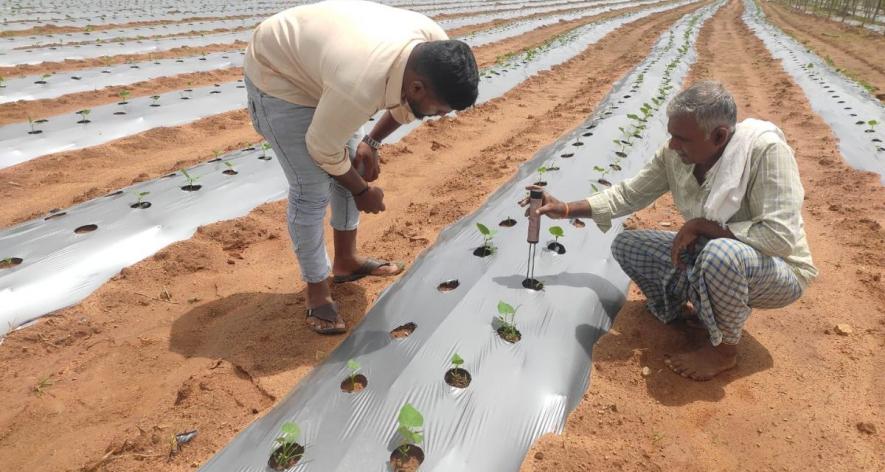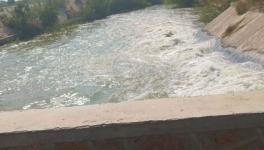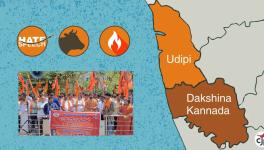Karnataka: Every drop matters in making Kolar's agricultural landscape sustainable

Kolar: “A total loss,” cries Venkateshappa (55) of Byrakur in Mulbagal taluka of Kolar when asked about last year’s cultivation. With great hopes, he had cultivated groundnut on two acres, but the damage was inexplicable, with the year being exceptionally dry.
The case of MG Pappama (62), a member of Grameena Mahila Okkutta (a federation of women’s self-help groups) at Minijenahalli, is no different. The ragi (finger millet) and tur (pigeon pea plant) on her two acres gave only negligible output. “Germination was extremely low due to lack of moisture. My farm has no borewell, so I am dependent on rain,” she says.
The ‘Drought-prone’ label is not new to the water-stressed Kolar district, which lies in the southeastern dry zone of Karnataka and is vulnerable to changes in climate, land use, and declining natural resources. The absence of a forest canopy, soil with no organic humus, vagaries of monsoon, frequent dry spells, and inadequate and ill-distributed rains have affected crop production and productivity here.
Of the total geographical area of 3,74,916 hectares (ha), 1,70,591 ha (45.5%) is cultivated, making agriculture the mainstay. Groundwater is overexploited in all six talukas of the district and can be accessed only at a depth of 1,500 ft. The district has 81,837 borewells and 726 micro-watersheds.
"Open wells and minor irrigation tanks were the major irrigation sources from 1970 to 1985. When rainfall became unpredictable, farmers started extracting groundwater from deeper aquifers. Since 2000, borewell digging has been extensively incentivised,” says MVN Rao, executive director of Grama Vikas, an NGO working for integrated rural development in Kolar.
“All my ancestors were neergantis [they released water to fields in exchange for grains produced there], but we now witness a shift towards borewells. No one relies on kere [lake] due to irregular rainfall,” says Amar Neerganti (58) from Mulbagal.
Praveena Kumara V, Department of Geology, Central University of Karnataka, Kalaburagi, analysed rainfall data for the past 100 years (1901-2015) of Kolar district and his reports indicate the chances of drought occurrence in Kolar once every two years.
Data from the Central Ground Water Board found that the annual average of normal rainfall ranged from 650 mm at Gudibanda in the north to around 800 mm at Mulbagal in the east, averaging 740 mm in the district. The average normal rainfall in all Kolar districts was 735 mm for 2020-2023. The actual rainfall varied from 983 mm (2020), 1,316 mm (2021) and 1,250 mm (2022) to the lowest in 2023 at 678 mm. However, these figures do not show the complete picture of the extent of drought, as the above-normal rain was received during July, which statistically helped bridge the deficiency.
A study by Kaushal K Garg of the International Crops Research Institute for the Semi-Arid Tropics (ICRISAT) reveals that between 1972 and 2011, there was a major shift from grass and rain-fed croplands to eucalyptus plantation and irrigated cultivation. The irrigation demand of the district increased from 57 mm (1972) to 140 mm (2011), which increased groundwater abstraction by 145%. The expansion of irrigated areas contributed majorly towards the widening demand-supply gap (62%) of freshwater availability.
“Large-scale land conversion to eucalyptus is also believed to have contributed to groundwater depletion and surface run-off reduction. By the time the eucalyptus ban came about in February 2017, groundwater was already in trouble,” says B Prabhakar (52) of Mulbagal taluka.
In its aftermath, most tanks/lakes suffered from a lack of maintenance. “Silt and invasive plants such as Eichhornia filled them, while many tank bunds were damaged. They were also encroached upon,” says Jayalakshmi Rao, administrator, Grameena Mahila Okkutta, Honnasetthalli, Mulbagal.
“Between 85 and 90% of all water consumed is used for agriculture. About 30% of the farmers have adopted a change in cropping patterns and water-efficient practices such as drip irrigation and sprinklers. Still, it is not enough,” Raghavendra Sudi, a retired ICRISAT senior scientist who works as a consultant (watershed) for Myrada, tells 101Reporters.
“Water availability, water use and entitlements are the basic elements of comprehensive drought proofing. Availability has to be assessed and developed, water use has to be monitored and conserved, and entitlements have to be ensured to the vulnerable sections,” he adds.
Extensive monocropping
Major crops cultivated in Kolar are ragi, maize, tur, horse gram, groundnut, cowpea and vegetables. However, a shift towards monocropping of water-intensive cash crops and horticultural produce such as flowers and tomatoes is on the rise.
“High input practices disrupt local ecosystems, climate, community nutrition and financial security. The native seed varieties used in akkadi saalu [a traditional intercropping system] produce more yield than hybrids. Plus this yield does not decrease with time,” claims Prabhakar's mother Rajamma (70), who has been rotating 18 to 20 types of crops in an acre according to the seasons.
“Unfavourable climate has caused unknown viral disease in tomatoes,” says Geeta (32) of Hiranya Goudanahalli in Mulbagal. She is struggling to meet her expenses of two lakh per acre thanks to low yield and price fluctuations.
Meanwhile, Ramesh Kumar, a panchayat development officer in Kolar, says farmers continued to grow tomatoes after multiple losses because they thought about making huge money in the short term. “They tend to forget that it is subject to market demand,” he adds.
The saving grace is that some farmers are gradually opening up to akkadi saalu and organic farming. “Diversity was there 40 years ago. Subsidised chemicals and fertilisers made people shift to high-income crops. I have restarted akkadi saalu movement in parts of Kolar, but it is yet to attract small farmholders. Diversification and value addition are things every farmer should think of in this changing climate,” says Prabhakar, who has been doing akkadi saalu in his two-acre farm.
Narayanaswamy Dharmalingam (59) of Byrakur has been an organic farmer for the last two decades. “I have identified many techniques that can recharge and sustain soil moisture. The agricultural department should hold awareness sessions for smallholders,” he says.
Prabhakar hopes akkadi saalu will come back if the government provides subsidies for farmers to make the transition from monocropping to multicropping.
Shiva Shankar, programme officer Kolar project, Myrada, an NGO working in backward areas, believes only 40% water use efficiency is achieved. "This can be attributed to percolation of water in the fields into the ground, spillage, seepage and evaporation.”
Myrada has been running a project on sustainable management of water resources and drought-proofing in Kolar since 2019. “We work with around 500 farmers,” says Ganamolla Sushmitha, agronomist, Myrada.
Chikkaramyya Muddegowda (33) from Bellavi in Malur taluka earlier used three to five kg ragi seeds per ha to get 30 quintal yield and 60 quintal fodder per ha. “Gulli method [System of Ragi Intensification] reduced the seed rate to 1.25 kg per ha and increased the grain and fodder yields to 70 and 80 quintals, respectively,” says Sushmitha.
Siddappa Rajendra (40) of Chakanahalli in Malur switched to vermicompost to save Rs 10,000 on input costs last year. "I got an extra 10 quintal yield than the previous year.”
Chikkyerappa Gopalappa (55) of Bellavi in Malur has been making use of soil moisture indicators, open well recharge pits and flow metre. “Besides my two acres where I cultivate ragi, I have got another six acres on lease for vegetables. My yield has increased as my open wells are full,” he beams.
“Micro irrigation, bio-mulching, sustainable practices for dry land cultivation, bringing in eucalyptus plots under regular agricultural practices, water conservation and climate-resilient practices should be the focus. If 70% of farmers adopt efficient irrigation and sustainable agriculture practices, water can be saved,” says Sudi.
Watershed management
The ongoing Watershed Development Component- Pradhan Mantri Krishi Sinchayee Yojana (WDC-PMKSY 2.0) is an effective drought mitigation measure. The agriculture department adopts integrated watershed management in 3,442.71 ha in Mulbagal and 4,327.57 ha in Srinivasapura from ridge to valley by involving stakeholders of land parcels of the watershed area. The project launched in 2021-22 is expected to finish in 2025-26.
“Supply-side interventions such as check dams, trench-cum-bunds, farm ponds and open well recharge pits, and demand side management such as tank desilting, use of drought mitigation tools, including soil moisture indicators and water flow metres, show improved water efficiency,” claims Veeresha NS, project engineer, Myrada’s Kolar project.
Sheikhmanpura tank in Malur was not deep enough to hold runoff until its renovation work began last July. A tank utilisation group (TUG) was formed for its maintenance. “With local help, 11,094 cubic metres silt was removed. Farmers paid for transporting silt to their farmlands for use as manure. Corporate social responsibility fund worth Rs 4.96 lakh from Imperial Tobacco Company was also utilised,” Veeresh details.
Before the Alagondanahalli tank in Bengaluru Rural was desilted in 2019, the area’s water table was at 59 m (from the ground level). “There was a 5 m increase in 2020, which jumped to 11 m the next year,” says Channarayappa (55), a farmer from Alagondanahalli.
“We expect Sheikhmanpura tank to provide similar results in recharging borewells,” says Veeresh.
According to Jayalakshmi, each tank requires a TUG to ensure community participation in kind and cash for desilting, cleaning catchment areas and planting native trees.
BN Krishnakanth and BC Nagaraja from the Department of Environmental Sciences, Bangalore University, have observed in their research paper that there were still significant gaps in effective implementation and percolation of benefits to the end users. More importance should be given to precise farming, sustainable agriculture and irrigation practices, soil nutrient management, watershed development, dairying and animal husbandry, the study says.
(Dr Lakshmi Unnithan is a Karnataka-based freelance journalist and a member of 101Reporters, a pan-India network of grassroots reporters.)
Get the latest reports & analysis with people's perspective on Protests, movements & deep analytical videos, discussions of the current affairs in your Telegram app. Subscribe to NewsClick's Telegram channel & get Real-Time updates on stories, as they get published on our website.
























